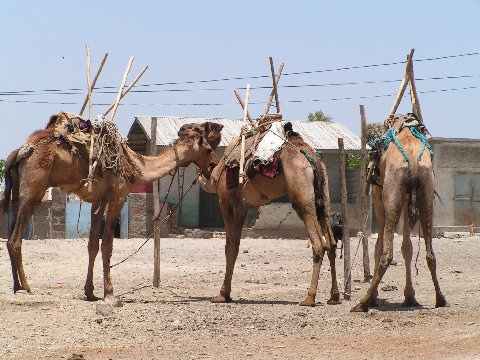In a very poor country it is important for companies to safeguard their assets. In the case of SEF, we have a large gated-courtyard in front of our office with several lockable storage sheds within. We park our SEF vehicles in the courtyard and lock the gate. However, an energetic thief could scale the courtyard fence, unlock the gate from the inside and abscond with a vehicle or with some solar systems from our inventory. But this has never happened. SEF, like most businesses and like many upper crust home owners, has an on site guard. Typically the guard is on duty 24/7/365.
Our watchman lives in a 3×7 foot guard shack in the courtyard. He sleeps on the shack floor and uses one of the office restrooms as his bathing area. He buys very cheap food on the street. I have asked several of my SEF colleagues what his name is. Most do not know, even though he guards their business compound 24/7. Except for a few weeks annual leave each summer, the guard is on duty non-stop. He visits his family in the countryside only during his summer leave. Otherwise, he seldom sees them. What a way to live. The guard’s speech is mostly unintelligible, perhaps due to a speech defect or maybe a mental shortcoming. I don’t know.
But in a sense he is very lucky: He has a full time (very full time) job and a roof over his head, albeit in a 3×7 room. Many other unskilled people with similar defects sleep and beg on the streets. He earns less than $3 per day, but it is steady money.
Currently SEF is attempting to computerize what has been, up to now, a paper-based activity: Recording and tracking the loans given to customers so that they can purchase a solar home system. (Cost is around $500, and for most customers a purchase of this size requires a three year loan.)
SEF has made loans to nearly 1000 customers, and all these loans have been recorded by hand. But as SEF grows to 5,000…10,000…50,000 customers, such a paper-based system would become overwhelmingly cumbersome. Hence the introduction of a computer-based system.
Now this introduction entails a substantial training program. SEF has contracted the design of the computerized loan system and the subsequent training to a vendor from southern Mexico. The very friendly Mexican contractor arrived with a decent, but imperfect command of English. The SEF personnel being trained arrived in class with a somewhat challenged understanding of English.
So, when the trainer asks a question in fractured English, the SEF personnel do not respond: maybe they don’t understand, maybe they understand but are not capable of formulating a response. Each student, working on a laptop, is attempting mightily to keep pace with the instructor’s not-totally-clear explanations. But several students are unfamiliar with computer use; and all are struggling to follow his English. Most have fallen behind the instructor’s lesson…but due to politeness or shyness or inability, they never ask him to slow down or to repeat.
I do my best to alert the trainer when it is necessary for him to slow down or repeat, but I am not always present in the training room; I have other things to do. Consequently, I suspect that the students are absorbing only a portion of the lesson transmitted.
Bottom line: One of the great challenges of business education in a developing country is full communication. Full communication seldom happens and this is one reason developing countries struggle mightily to catch up to the more technologically advanced nations.
Now for your reading enjoyment, I share some of my favorite fractured commands from the draft computerized loan system – – imagine yourself filling out an on-line loan application and trying to figure out the meaning of the following buttons:
- Customer could not assist meeting
- Family expense reasonably
- Operating costs personably
The latter has a drop down menu with the following choices: High Regular Low. It must be comforting to know a customer has “operating costs personably, regular.” In my last remaining days at SEF I have made it my assignment to help make some sense of this new system.
Last weekend seven of us journeyed to Rema – – four Ethiopians, the Mexican mentioned above, and Robin and me. This was my third visit to SEF’s training facility five hours of spectacular scenery north of Addis. And this time, at the tail end of the rainy season, it was greener than ever. Waterfalls plunged over previously bone-dry cliffs and streams rushed down formerly parched gullies.
One purpose of the journey was to repair a faulty solar-powered refrigerator in the local bar. With the fridge on the blink the bar owner had reverted to the pre-solar way of cooling drinks. He buried them in the sand. I discovered that a sand cooled beer is only slightly cooler than the 85 degree air temperature. I think the entire town of Rema was relieved when our solar technician got the fridge back on line.
That night our Ethiopian hosts, mostly in their early 20s, taught us the traditional dance from each of four major Ethiopian ethnic groups. For those of you contemplating a visit to the disco soon, here is a guide to the dances:
- Amharic – the famous shoulder shaking dance
- Tigrinya – in a circle, kind of an ethnic bunny hop
- Gurage – hands in prayer position, pointed forward, cross stepping back and forth
- Oromo – hands behind the back, stepping forward and backwards
The moves of each were quite different but the music sound pretty much all the same to my untrained ear. Robin and I demonstrated my strongest dance: the twist. The twenty-somethings Ethiopians were vaguely familiar with this genre.

